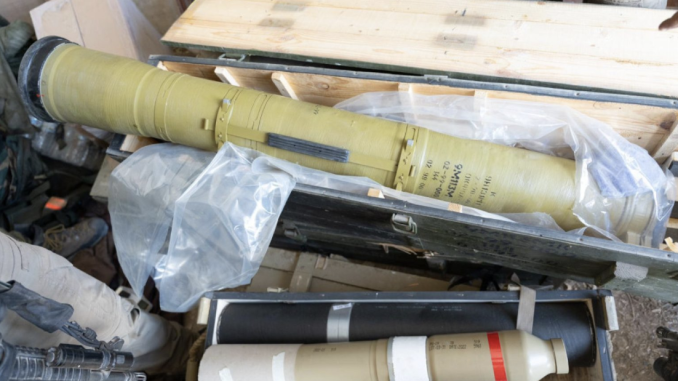By Seth Frantzman | October 17, 2024
 Weapons found in southern Lebanon by Israeli forces. (IDF photo)
Weapons found in southern Lebanon by Israeli forces. (IDF photo)
The Israel Defense Forces (IDF) carried out almost 500 strikes on various Hezbollah targets in three days of fighting between October 14 and October 17. The IDF said that troops “dismantled more than 150 Hezbollah terror targets” over a day of ground battles on October 17 alone. In addition, the IDF said that 140 Hezbollah targets had been struck from the air on October 16, with another 200 hit the day before. The targets included “weapons storage facilities, launchers aimed toward Israeli territory, terrorist infrastructure, and terrorist cells,” according to the IDF.
The Israeli military continues to move cautiously and systematically in operations near the Israeli border. Ground forces have been fighting Hezbollah for two weeks, and the IDF now has elements of two divisions in southern Lebanon. Israel characterizes the fighting as “limited, localized, targeted raids based on precise intelligence in southern Lebanon.” Thus, although the frontline along the Lebanese border is 80 miles long and consists of rolling hills, valleys, and ravines, with Lebanese villages perched on the top of hills and plateaus, there are no significant operations along much of the front.
Soldiers with the 8th Armored Reserve Brigade, which is operating under the 91st Division responsible for defending Israel’s northern border, found a tunnel in southern Lebanon. IDF combat engineers found the tunnel, which was determined to be a half-mile long. The IDF said that the passage served as an operations center for Hezbollah’s elite Radwan Force.
“Inside the underground compound, the IDF found helicopter-fired missiles, mortar shells, motorcycles, living quarters, and means for long-term stays, including a kitchen stocked with food and supplies.” The IDF believes this tunnel was supposed to support offensive operations by Radwan so that Hezbollah fighters could emerge suddenly and strike towards Israel. Ynet reported that the tunnel was intended for use in attacks on the northern Israeli city of Kiryat Shmona.
The IDF didn’t specify where the tunnel was found, though context puts it in the eastern sector of the border area. “They were planning, with these motorcycles here, to enter Kiryat Shemona, to Yiftah, to villages and positions inside Israel and conduct a massacre. They were here only a couple of days ago,” IDF Spokesperson Rear Admiral Daniel Hagari said of the tunnel. Yiftah is an Israeli kibbutz on a ridgeline southwest of Kiryat Shmona, and Hezbollah would have had to penetrate this high point to strike down into the valley. Throughout the war, Hezbollah has targeted this ridgeline and communities directly on the Lebanese border, such as Manara and Magaliot.
In another sector, the IDF’s 228th Brigade, also under the 91st Division, carried out additional raids and found weapons. “The brigade has uncovered dozens of terrorist tunnel shafts and significant underground infrastructure,” the IDF said. In a separate incident, Israeli troops captured a Hezbollah member who was hiding in a tunnel shaft. An interrogation of the man was filmed, and part of it was released to the public by the IDF. In the video, the Hezbollah member says that his commanders in the sector had fled.
The systematic pattern of Israeli advances and the slow, complex process of uncovering terrorist infrastructure is similar in various areas of the front. The IDF’s 98th Division of paratroopers and commandos also found Hezbollah weapons, including mortars, rockets, and anti-tank missile launchers, according to an IDF statement on October 16. Soldiers with the Golani Infantry Brigade, part of the IDF’s 36th Division, also found Kornet anti-tank missiles, 100 mortar shells, four tunnel shafts, and “numerous AT-3 Sagger missiles” in operations over several days.
The 146th Reserve Division, which entered Lebanon on October 8, has coordinated with the Israeli Navy to conduct strikes on Hezbollah targets. “The IDF’s multi-branch capability in combat is evident in the offensive operation ‘Northern Arrows.’ Missile ships, patrol vessels, intelligence posts, command posts, fire control, and other means play an integral role in offensive and defensive missions in the northern arena, and supporting the troops of the 146th Division,” said Rear Admiral Eli Soholitzky, commanding officer of the Haifa Naval Region, on October 16.
In addition, the Israeli Air Force has continued operations, carrying out a strike in Beirut and the Bekaa Valley on October 16. The Beirut strike came after six days in which there had been no airstrikes in the Lebanese capital. In southern Lebanon, Israeli warplanes targeted a Hezbollah commander named Khader Al-Abed Bahja, who the IDF said was responsible for drone operations in one Hezbollah sector. The IDF accused him of “numerous” attacks against Israeli forces. In another strike, warplanes hit Nabatieh, a major Lebanese city about 10 miles north of Israel’s border. “The targets include terrorist infrastructure sites, Hezbollah command centers, and weapons storage facilities,” the IDF said.
In another airstrike, Hezbollah commander Jalal Mustafa Hariri, who was responsible for the area of Qana, was killed. In addition, the IDF used artillery and airstrikes to target a Hezbollah commander in Bin Jbeil.
Hezbollah continues to launch barrages of rockets into Israel. The IDF provided incomplete details but said that approximately 90 projectiles were fired on October 14, 95 on October 15, and 90 in the first half of October 16. Sirens also sounded throughout October 17, and it appears that dozens of rockets were launched at northern Israel near the Lebanese border and also targeting Haifa and nearby areas.



Leave a Reply
You must be logged in to post a comment.